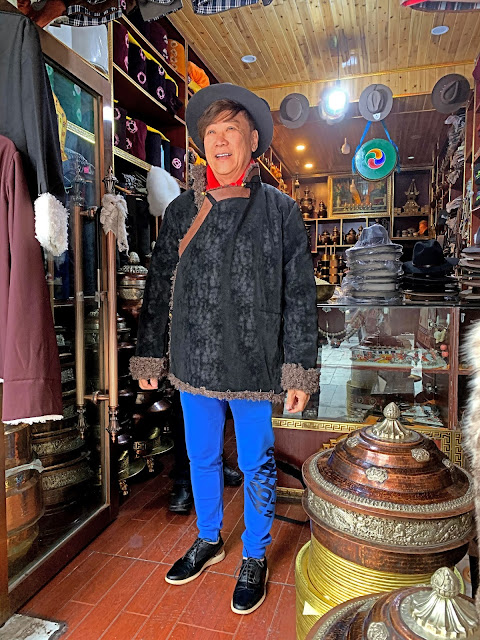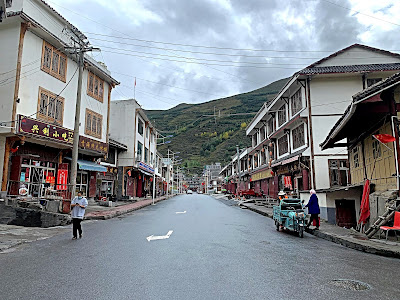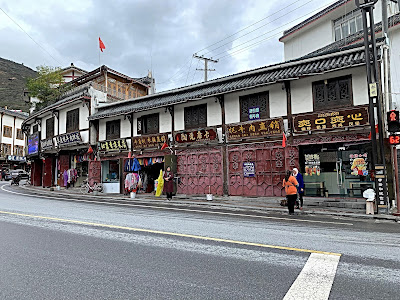Songzhou Ancient City
I was confused when I was reading about this town. I am still not quite sure about its proper name but some know it as Songpan Ancient City and it was historically known as Songzhou. However, the locals call this town Songzhou.
According to history:
Songpan Ancient City was formed in 618 during the Tang Dynasty; a merger of Songzhou Guardian and Panzhou Guardian. It was a military base during the Tang Dynasty. It was rebuilt during the Ming Dynasty. This city was divided into an inner city and an outer city.
The city wall is 12.5 meters high (41 feet) and 12 meters thick.
Can you believe that the mortar used was a mixture of glutinous rice, lime and tung oil (Chinese wood oil), boiled together?
Princess Wencheng and Tubo King Songtsan Gambo
The marriage between Han and Tibet
There was war between the Tang Dynasty and the Tubo Dynasty (Tibet). Princess Wencheng of the Tang Dynasty left Chang'an (Xi'an) to marry The King of Tubo so as to maintain peaceful relations between the Han and Tibet. This marriage has maintained an important historical event in the hearts of the TIbetan and Chinese people until today.
Princess Wencheng brought the Chinese Han culture to Tibet. She introduced Buddhism by bringing over Buddhist pagodas, scriptures and statues into her new home. She also taught the Tibetan people farming techniques, and the Tibetan women, skills of weaving and embroidery. Children of Tubo nobles were sent to study the Chinese culture. Princess Wencheng still is the most famous and beloved queen in Tibetan history.
A beautiful Tibetan lady
The weather was not on our side that day. We were lucky to have about an hour exploring this town and then it poured cats and dogs. I think I did have enough to create a short video of this town as it was a memorable visit. The Tibetan shop owners were so kind, friendly and gentle. I would have loved to spend a whole day here. Grateful that we had the opportunity to visit such a lovely historical town in Sichuan.
Outside the City Wall
There is a pavillion right on top of this hill, can you see it? It is closed to the public but I can imagine the amazing view of the ancient city from up there.
Many shops are selling the parts of the Yak.
Yak's penis
Yak's tongue
More Yak's penises
Qingke wine
The shops outside the ancient city are also very interesting. A lot of them sell parts of the Yak. The penises, I learnt, are usually soaked in white wine, and the people drink the wine for strength. They also boil the parts of the Yak for soup.
The YAK
The Yak plays an important part in the Tibetan people's lives:
Yaks are used for transportation.
The Yak's fur is called Kullu; it is used for winter clothing because its wool can withstand the heaviest winter conditions. The wool is also used to make bags, blankets, carpets, sling shots and string.
The Yak's coarse hair is used to make tents.
The Yak's skin is made into leather; for clothes, mats and for wrapping food.
The Yak's milk is medicinal. I have tried candy made of its milk; very potent and fragrant. It's also used to make cheese, yogurt, and butter. The Tibetan's Butter Tea is yummy.
Yak meat is a Tibetan's delicacy; well known for its nutritional content and low in fat.
The tail of a Yak is used as a broom!
Yak dung is used as a substitute for coal.
Yak bones are also used for medicinal purposes.
Yak's penis is used for soup or soak in white wine, for strength, or cooked in chili oil.
Yak's horns are used to make combs and pipes.
The Tibetan people worship the Yak's head because yaks are useful to them and known as 'Norbu' (treasure).







































































No comments:
Post a Comment